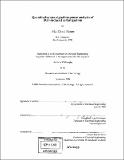Quantitative cue-signal-response analysis of EGF-induced cell migration
Author(s)
Harms, Brian David, 1976-
DownloadFull printable version (8.472Mb)
Other Contributors
Massachusetts Institute of Technology. Dept. of Chemical Engineering.
Advisor
Douglas A. Lauffenburger.
Terms of use
Metadata
Show full item recordAbstract
(cont.) curve is explained mechanistically by the results of the first study. In a final study, we investigated the phenomenological structure of CHO-EGFR cell paths using turn angle distribution and time series analyses. Increased local cell speed correlated with increased likelihood of local directional persistence, a result independent of biochemical modulation of overall cell motility. Time-based directional autocorrelations were observed that indicate an unusual non-Markov behavior in CHO migration. Overall, these studies demonstrate how biophysical analysis is an effective tool for gaining insight into the quantitative regulation of motility by intracellular signaling. The physiological importance of cell motility has resulted in intense efforts dedicated towards deconstructing its molecular control mechanisms. Most research employs qualitative approaches, yet quantitative understanding of how altering the function of genes or proteins changes migration responses is critical for engineering therapies targeting pathological cell motility. In this work, we deconstruct hierarchical quantitative relationships between biochemical, biophysical, and phenomenological descriptions of cell motility. Specifically, this thesis establishes quantitative correlations between the activation of key intracellular signaling proteins by extracellular motility cues and the effects of these signals on both the biophysical processes comprising motility and parameters describing the overall paths of translocating cells. Our model system consisted of Chinese Hamster Ovary (CHO) cells transfected with the epidermal growth factor (EGF) receptor. In initial experiments employing EGF and fibronectin (Fn) as extracellular cues, we found that adhesion-mediated stabilization of lamellipodial protrusions governed the magnitude of directional persistence in cell paths. To connect this biophysical control of persistence to intracellular signaling, a second study examined the role of extracellular signal-related kinase (ERK) and phosphatidylinositol 3-kinase (PI3K) signaling in EGF-induced migration. Both molecules controlled directional persistence biphasically, with maximal persistence at intermediate signal strength. Studies of lamellipodial protrusion, in concert with experiments using soluble anti-adhesion peptides to modulate persistence, indicated that the ERK, but not the PI3K, biphasic
Description
Thesis (Ph. D.)--Massachusetts Institute of Technology, Dept. of Chemical Engineering, 2004. Page 172 blank. Includes bibliographical references.
Date issued
2004Department
Massachusetts Institute of Technology. Department of Chemical EngineeringPublisher
Massachusetts Institute of Technology
Keywords
Chemical Engineering.